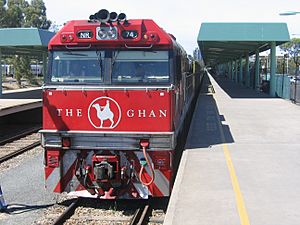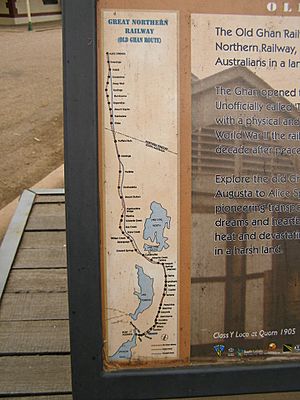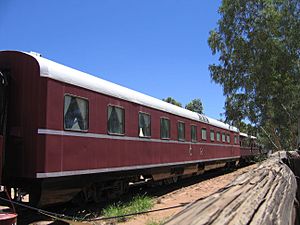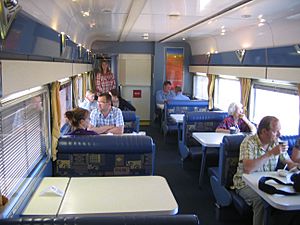The Ghan facts for kids
|}
The Ghan is a famous passenger train in Australia. It travels a long distance between Adelaide in the south, Alice Springs in the middle, and Darwin in the north. This journey happens on the Adelaide–Darwin railway. The company that runs the train is called Great Southern Rail. The whole trip takes about 54 hours. It covers a distance of 2,979 kilometres (1,851 mi). There is a four-hour stop in Alice Springs where passengers can explore.
Contents
The Name of The Ghan
The train's name, The Ghan, is a shorter version of its old nickname, The Afghan Express. People say this nickname was first used in 1923 by one of the train's crew members. The name honors the Afghan camel drivers. These drivers came to Australia in the late 1800s. They helped explore the country's unknown inland areas.
Some people also believe the name was first used as a joke. In 1891, the railway line reached Oodnadatta. This town was home to about 150 camel drivers, often called 'Afghans'. Train crews in the 1890s used 'The Ghan Express' as a funny name. This was because once, when a fancy sleeping car was added, the only passenger on its first return trip was an Afghan. By 1924, the train was known as 'The Afghan Express' because it was often very late. Sometimes it was days or even weeks behind schedule. When steam engines were replaced by diesel-electric trains in 1951, the old jokes about the name faded away. Today, the name is used with pride. It celebrates the train's long history and connection to Australia's past.
How The Ghan Runs Today
The Ghan was sold to a private company in 1997. It is now run by Great Southern Rail. This company was bought by Allegro Funds, an investment group from Sydney, in March 2015.
Usually, The Ghan runs once a week all year round. In December 2012 and January 2013, it ran only every two weeks. Until 2016, a second train service ran between June and September. The train makes stops in Alice Springs and Katherine. This allows passengers to get off and go on special tours if they want.
Each Ghan train has between 16 and 26 stainless steel carriages. These carriages were built a long time ago, in the late 1960s and early 1970s. They were made for another famous train called the Indian Pacific. The train also includes a motorail wagon. This wagon allows passengers to bring their cars or motorcycles with them. A Pacific National NR class locomotive pulls the train. Sometimes, other locomotives like an AN class or a DL class join the NR class to help pull the long train.
History of The Ghan
Early Days of The Ghan
The Ghan first started running in August 1929. It ran on the Central Australian Railway. This was a 1,070 mm (3 ft 6 in) narrow-gauge railway. This means the tracks were closer together than standard tracks. This line went to Alice Springs. In 1957, a new standard gauge line opened. This line had wider tracks, 1,436 mm (57 in) apart. It went from Stirling North to Marree. After this, The Ghan only ran north of Marree. In October 1980, a completely new standard gauge line was built. It was located to the west of the old line. This new line was later extended even further north, from Alice Springs all the way to Darwin. This final section opened in January 2004.
The Original Ghan Train
Building the railway from Port Augusta to Government Gums started in 1878. The Premier of South Australia, William Jervois, began the work. The 1,070 mm (3 ft 6 in) narrow-gauge line reached Hawker in June 1880. It then reached Beltana in July 1881, Marree in January 1884, and Oodnadatta in January 1891. In 1926, work began to extend the line to Alice Springs. This part was finished in 1929. Before the train reached Alice Springs, the last part of the journey was made by camel.
There were always plans to build the railway all the way to Darwin. However, by the time the line reached Alice Springs, The Ghan was not making much money. So, plans to reach Darwin were put on hold for a long time. The original railway line followed the same path as the Australian Overland Telegraph Line. This path is thought to be the route taken by John McDouall Stuart when he crossed Australia in 1862.
Old Steam locomotives needed a lot of water to run. Stuart's route to Alice Springs was the only one that had water available. But this also meant that when it rained a lot, the creeks and rivers would often wash away the railway tracks. The Ghan train was famous for long delays because of these washouts. A special flat car was carried behind the locomotive. It held spare wooden sleepers and railway tools. This way, if the track was damaged, passengers and crew could help repair the line. During World War II, the train service had to carry many more people and goods. This put a lot of pressure on the limited water supplies. To fix this, special de-mineralisation towers were built along the track. These towers cleaned bore water so it could be used in the locomotives. Some of these towers can still be seen today. When the new line to Alice Springs was built in the 1970s, diesel engines were used. These engines needed much less water. This meant the new line could take a much drier route from Tarcoola to Alice Springs.
The original Ghan train was featured in a BBC Television series called Great Railway Journeys of the World in 1980.
The New Ghan Line
The original Ghan train made its last journey in 1980. A group called The Ghan Preservation Society has fixed parts of the old narrow-gauge track. In October 1980, a new standard gauge line opened. This line went from Tarcoola, on the Trans-Australian Railway, to Alice Springs. The new line is about 160 kilometres (99 mi) west of the old one. This new path helps the train avoid the floodplains. The old line was often damaged by floods in these areas. It was also hoped that the new line would help the train run on time more often.
The modern Ghan was shown in an episode of Channel 5's series Chris Tarrant: Extreme Railways. In November 1998, one of the train services went from Adelaide to Melbourne. From April 1999, another service went to Sydney.
Connecting to Darwin
Building the railway line between Alice Springs and Darwin was a huge project. It is said to be the second-largest civil engineering project in Australia. The biggest was the Snowy Mountains Scheme, built between 1949 and 1974. Work on the Alice Springs to Darwin line began in July 2001. The very first passenger train reached Darwin on 4 February 2004. This happened after 126 years of planning and waiting! The total cost of building this line was A$1.3 billion.
The Ghan's arrival in Darwin started a new time for tourism in the Northern Territory. It made travel to the area much easier. It also improved access for Aboriginal communities. The railway link will allow more goods to be transported through the region. People hope that Darwin will become an important trade link with Asia because of this.
One of the locomotives was even named after Steve Irwin. This was done to help promote the new train service and encourage more people to visit the region.
Incidents Involving The Ghan
- On 24 October 2002, The Ghan crashed into a school bus in Salisbury, South Australia. Sadly, some people on the bus lost their lives. However, no passengers on The Ghan were seriously hurt.
- On 12 December 2006, The Ghan hit a truck at a railway crossing. This happened about 35 km south of Adelaide River in the Northern Territory. Seven of the 11 carriages came off the tracks. One woman was seriously injured, but other passengers had only minor injuries. The truck driver was found responsible for the accident.
- On 4 March 2007, heavy rains washed away part of the track between Darwin and Adelaide River. While the track was being repaired, all trains had to stop at Katherine.
- On 6 August 2007, The Ghan crashed into a truck at a railway crossing. This was about 50 km (31 mi) north of Adelaide in South Australia. Three passengers reported minor injuries due to shock. The truck driver was temporarily stuck in his vehicle.
- On 6 June 2009, a 19-year-old American tourist held onto the outside of The Ghan for two hours. He traveled 200 km this way! After a stop in Port Augusta, he found himself locked out of the train, with his passport and luggage inside. He was only rescued when a technician heard his shouts and stopped the train.
Images for kids
See also
 In Spanish: The Ghan para niños
In Spanish: The Ghan para niños













